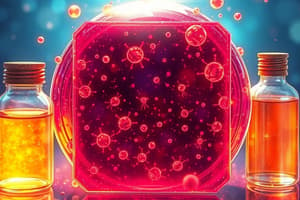Podcast
Questions and Answers
What is a key parameter for the purity of antibodies?
What is a key parameter for the purity of antibodies?
- Affinity purification (correct)
- Source species
- Stability of the antibody
- Molecular weight
Which buffer is not mentioned as a coating buffer?
Which buffer is not mentioned as a coating buffer?
- PBS
- Carbonate-bicarbonate
- Tris-acetate (correct)
- TBS
What is typically used as a blocking agent?
What is typically used as a blocking agent?
- 0.5% BSA
- 1% gelatin
- 0.1% SDS
- 10% host serum (correct)
Which of the following is a characteristic of horseradish peroxidase (HRP) substrates?
Which of the following is a characteristic of horseradish peroxidase (HRP) substrates?
What is an essential aspect of standard quality in assays?
What is an essential aspect of standard quality in assays?
What concentration of sodium bicarbonate is used in one of the coating buffers?
What concentration of sodium bicarbonate is used in one of the coating buffers?
Which is a stop solution for HRP/TMB?
Which is a stop solution for HRP/TMB?
In sandwich immunoassays, how many antibodies are typically used?
In sandwich immunoassays, how many antibodies are typically used?
What is the first step in developing an immunoassay?
What is the first step in developing an immunoassay?
Which of the following is NOT considered a critical success factor in assay development?
Which of the following is NOT considered a critical success factor in assay development?
Which stage follows acquiring reagents in the assay development process?
Which stage follows acquiring reagents in the assay development process?
What is a primary consideration when selecting the type of immunoassay to develop?
What is a primary consideration when selecting the type of immunoassay to develop?
Which of the following does NOT represent an optimisation parameter related to reagents?
Which of the following does NOT represent an optimisation parameter related to reagents?
During which stage of assay development is robustness and reproducibility evaluated?
During which stage of assay development is robustness and reproducibility evaluated?
What is essential to block in an immunoassay to reduce background noise?
What is essential to block in an immunoassay to reduce background noise?
Which factor is involved in the final stage of an immunoassay's process?
Which factor is involved in the final stage of an immunoassay's process?
Flashcards
Analyte
Analyte
The specific substance you want to measure in your experiment.
Sample Matrix
Sample Matrix
The type of sample you're testing (e.g., blood serum, cell media).
Sensitivity
Sensitivity
The level of accuracy and precision needed to detect the analyte.
Measurable Range
Measurable Range
Signup and view all the flashcards
Accuracy
Accuracy
Signup and view all the flashcards
Precision
Precision
Signup and view all the flashcards
Reagents
Reagents
Signup and view all the flashcards
Detection Mode
Detection Mode
Signup and view all the flashcards
What does 'quality of standards and antibodies' refer to?
What does 'quality of standards and antibodies' refer to?
Signup and view all the flashcards
What is 'quantity of standards and antibodies'?
What is 'quantity of standards and antibodies'?
Signup and view all the flashcards
What is 'purity of standards and antibodies'?
What is 'purity of standards and antibodies'?
Signup and view all the flashcards
What are 'selectivity and specificity of antibodies'?
What are 'selectivity and specificity of antibodies'?
Signup and view all the flashcards
What are 'coating buffers' used for?
What are 'coating buffers' used for?
Signup and view all the flashcards
What are 'blocking buffers' used for?
What are 'blocking buffers' used for?
Signup and view all the flashcards
What are 'wash buffers' for?
What are 'wash buffers' for?
Signup and view all the flashcards
Why are standards important for an immunoassay?
Why are standards important for an immunoassay?
Signup and view all the flashcards
Study Notes
Immunoassay Optimisation
- Immunoassay optimisation involves a series of steps to ensure an effective and reliable assay
- Key factors for successful immunoassays need to be established before development and validation
- Critical success factors that need to be considered are: the analyte being measured, sample type e.g., serum; sources of antibodies, standards and detection reagents e.g., enzyme substrates; the detection mode e.g., colorimetric, fluorescence and detection equipment, such as plate readers.
- Stages of assay development include: establishing critical success factors; acquiring the necessary reagents; instrument testing using appropriate calibration and performance testing; proof-of-concept experiments to confirm assay parameters, and reagent suitability; selecting the optimal format for optimisation; validating the robustness, recovery, and reproducibility of the assay through analysis; and documenting the method.
- An immunoassay can be developed using either a sandwich or competitive approach.
- Immunoassays measure analyte concentration with predefined ranges expressed in pg/ml, ng/ml or mg/ml
- Data analysis is required for reporting the results appropriately.
- Recovery, accuracy, and precision are critical at the limits of quantitation and the measurable range of an analyte
- Automation is often needed to increase sample throughput.
- Suitable control samples are required for optimisation, validation and quality control
Optimisation Parameters - Reagents
- The quality, quantity, and purity of standards and antibodies are key parameters. Affinity-purified antibodies are often preferred for increased selectivity and specificity.
- Different coating buffers have varying compositions and are used to coat the solid surface. Examples include 50 mM sodium bicarbonate, pH 9.6; 0.2 M sodium bicarbonate, pH 9.4; Phosphate buffer (1.7 mM NaH2PO4, 98 mM Na2HPO4·7H2O, 0.1% NaN3, pH 8.5); and Tris-buffered saline (TBS) (50 mM TRIS, pH 8.0, 0.15 M NaCl).
- Blocking buffers prevent non-specific binding by blocking areas on the solid surface that are not specific binding sites. Examples include 1% bovine serum albumin (BSA) or 10% host serum in Tris-buffered saline with Tween-20 (TBS-T); phosphate buffer (73 mM Sucrose, 1.7 mM NaH2PO4, 98 mM Na2HPO4·7H2O, 0.1% NaN3, pH 8.5) with 1% bovine serum albumin (HSA) or other commercial blocking agents.
Optimisation Parameter - Wash Buffers
- Wash buffers like PBS-Tween (PBST) or Tris-buffered saline-Tween (TBST) are used to remove unbound materials, reducing background noise. PBST and TBST contain detergent (Tween-20) to improve washing and reduce non-specific binding.
Optimisation Parameter - Enzymes & Substrates
- Horseradish peroxidase (HRP) substrates such as 3,3',5,5'-tetramethylbenzidine (TMB), o-phenylenediamine (OPD), and 2,2'-azino-bis(3-ethylbenzthiazoline-6-sulfonic acid) (ABTS) produce a measurable signal, typically colorimetrically.
- Alkaline phosphatase substrates, like p-nitrophenyl phosphate (pNPP), are also used in some assays.
Optimisation Parameter - Stop Solutions
- Stop solutions, such as 2 M sulfuric acid (H₂SO₄), stop the enzymatic reaction by changing the pH and thus halting the colour development. Different enzymes require different stop solutions with different molarity e.g., HRP and TMB use the same stop solution. OPD and ABTS require different solutions e.g., 3M H2SO4.
Optimisation Parameter - Specific Antibodies
- Sandwich immunoassays use pairs of antibodies (one for capture and one for detection).
- In competitive immunoassays, a single antibody is used to measure the analyte competing with the analyte in the sample,
Optimisation Parameter - Standards
- Sufficient standards are used during development, validation and ongoing use of the assay method, to avoid changes in the lots of standards.
- Vendor information is essential when evaluating the standards' quality, particularly concerning stability, and storage recommendations are required.
Optimisation Parameter - Control samples
- Spiked controls are generated by adding a known concentration of the analyte into a sample matrix e.g., tissue culture or serum.
- Control samples are helpful to evaluate the assay performance when the same sample is run through different procedures.
Optimisation Parameter - Instrumentation
- Lineraity and performance need to be tested.
- Manufacturers' specifications on calibrations should be adhered to before use.
- Plate readers provide the absorbance, fluorescence, or chemiluminescence signals that are measured during the reaction.
- Instrument linearity should be assessed at the appropriate wavelength for measurement.
Studying That Suits You
Use AI to generate personalized quizzes and flashcards to suit your learning preferences.
Related Documents
Description
This quiz explores the essential steps involved in optimising immunoassays for reliability and effectiveness. Key factors such as analyte measurement, sample type, and detection modes are crucial in the development process. Additionally, it covers the stages of assay development, from reagent acquisition to validation and documentation.




